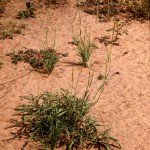Galleta , James' Galleta, Galleta Grass
Pleuraphis jamesii Torr.
Poaceae
Description
Galleta stems are highly branched at the base and grow from rough, scaly rhizomes. The seedhead stem (i.e., culm) is erect with solid internodes. Leaf blades are 1 to (>)2 inches long and ⅛ inch wide, curled, and roll inward when dry. There are 3 spikelets per node, and each spikelet has long hairs at the base. The large, papery glumes narrow at the apex and have awns measuring 4 to 5 mm long. Galleta resembles overgrown Tobosa but has glumes of lateral spikelets, not fan-shaped. Each lateral spikelet has three staminate florets, and the first glume of the lateral spikelets is awned on the back. The lower stem internodes do not have hairs, but the stem nodes are typically hairy. Flowering occurs from May to September. Galleta reproduces through seed and the development of buds on its rhizomes. Galleta is a perennial, warm-season, rhizomatous native ranging from 8 to 25 inches or 20 to 64 cm tall. Galleta can provide good forage for both livestock and wildlife when green but becomes poor to fair in value when dry.Habitat
Galleta is isolated to the Far West portion of Texas and grows on dry, rocky ledges, rolling slopes, valley flats, hills, and sandy plains. Plant communities may include chaparral, semi-desert grasslands, and woodlands. It is tolerant of arid environments with moisture directly affecting the flowering cycle. Galleta prefers neutral to moderately alkaline soils, with low water-holding capacity, and a coarse, loamy texture.Images
Plant Characteristics
Seed Type: Non-Encapsulated
Duration: Perennial
Stem Texture: Hairy
Growth Habit: Bunch grass, Grasses
Leaf Shape
 : Simple with Pinnate or Parallel Venation
: Simple with Pinnate or Parallel Venation
Season: Warm
Distribution
 : 08 - Rolling Plains, 09 - High Plains, 10 - Trans-Pecos
: 08 - Rolling Plains, 09 - High Plains, 10 - Trans-Pecos
Distributions
Distribution refers to the ecological region in Texas that a plant has been found. You can also view a clickable map.
Book: Know Your Grasses (B-182)
Collection: Grasses


